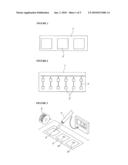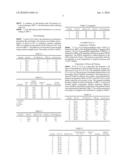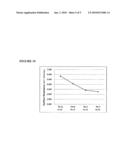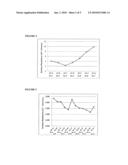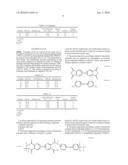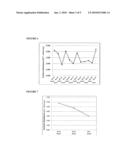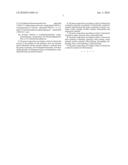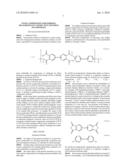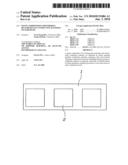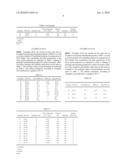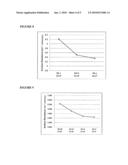Patent application title: Paste Composition for Forming Heat-Resistant Conductive Patterns on Substrate
Inventors:
Soon Yeong Heo (Cheonan-Si, KR)
Seong Sil Park (Cheonan-Si, KR)
Assignees:
EXAX INC.
IPC8 Class: AH01B112FI
USPC Class:
252511
Class name: Elemental carbon containing with organic component resin, rubber, or derivative thereof containing
Publication date: 2010-06-03
Patent application number: 20100133484
Inventors list |
Agents list |
Assignees list |
List by place |
Classification tree browser |
Top 100 Inventors |
Top 100 Agents |
Top 100 Assignees |
Usenet FAQ Index |
Documents |
Other FAQs |
Patent application title: Paste Composition for Forming Heat-Resistant Conductive Patterns on Substrate
Inventors:
Soon Yeong Heo
Seong Sil Park
Agents:
THE WEBB LAW FIRM, P.C.
Assignees:
EXAX INC.
Origin: PITTSBURGH, PA US
IPC8 Class: AH01B112FI
USPC Class:
252511
Publication date: 06/03/2010
Patent application number: 20100133484
Abstract:
A paste composition for forming heat-resistant and electrically conductive
patterns on substrate by direct printing includes conductive particles,
polyamic acid, and solvent. The paste composition can form solderable
electric circuits or solderable antenna on substrate, especially on
flexible sheets by direct printing to simplify processes, to save time
and cost, and to minimize waste.Claims:
1. A paste composition for forming heat-resistant and electrically
conductive patterns by direct printing comprising:conductive
particles;polyamic acid; andsolvent.
2. The paste composition according to claim 1, wherein the polyamic acid is defined as Formula 1 as below ##STR00003## where R1 and R2, respectively, are a hydrocarbon chain or a hetero-atomic chain having N, O and/or S, or indicate a bridge or fusion between benzene rings.
3. The paste composition according to claim 2, wherein the polyamic acid are prepared by polyaddition of aromatic diacid anhydride defined as formula 2 below and aromatic diamine defined as formula 3 below ##STR00004## where R1 and R2, respectively, are a hydrocarbon chain or a hetero-atomic chain having N, O and/or S, or indicate a bridge or fusion between benzene rings.
4. The paste composition according to claim 3, wherein the aromatic diacid anhydride defined is 1,2,4,5-benzentetracarboxylic dianhydride, 3,3',4,4'-benzophenonetetracarboxylic dianhydride ("BTDA"), oxydiphthalic anhydride ("ODPA"), 3,3',4,4'-diphenylsulfonetetracarboxylic anhydride("DSDA"), biphenyltetracarboxylic dianhydride("BPDA"), 3-hydroquinone-o,o'-diacetic anhydride("HQDA") or 2,2-bis[4-(3,4-dicarboxyphenoxy)phenyl]propane dianhydride("BPADA"); andthe aromatic diamine is m-phenylenediamine, p-phenylenediamine, oxydianyline, 4,4'-diaminodiphenylsulfone or 4,4'-diaminobenzophenone.
5. The paste composition according to claim 3, wherein the solvent or the medium for the polyamic acid, the aromatic diacid anhydride and the aromatic diamine is selected from the group consisting of N,N-dimethylformamide, N,N-dimethylacetamide, N-methylpyrrolidone, tetramethylurea, dimethylsulfoxide and mixture thereof.
6. The paste composition according to claim 3, wherein the conductive particles are particles of electrically conductive material selected from the group consisting of metal, nonmetal, oxides, carbides, borides, nitrides, carbonitrides and carboneous material.
7. The paste composition according to claim 1, wherein the substrate is paper, polyester film or polyimide film.
8. The paste composition according to claim 1, wherein the direct printing is brushing, spraying, roller coating, screen printing, gravure printing, offset printing, flexography, dispensing, rotary screen printing or inkjet printing.
9. The paste composition according to claim 1, wherein the conductive patterns are Rfid antenna.
Description:
DETAILED DESCRIPTION
[0001]1. Technical Field
[0002]The present invention is directed to a paste composition for forming heat-resistant conductive patterns on substrate, especially for forming heat-resistant conductive patterns solderable for components on substrate by direct printing to produce printed circuit boards (PCB) or flexible printed circuit boards (FPCB).
[0003]2. Technical Background
[0004]A PCB or a FPCB is the most basic electronic component with various components soldered or mounted on to function a device. A PCB or a FPCB is manufactured to have certain patterns or circuits by etching a copper clad laminate (CCL) or a flexible copper clad laminate (FCCL) respectively. A method of patterning through etching is called a "subtractive method".
[0005]On the other hand, researches and efforts have been made to apply an additive method by direct printing for relatively simple pattern forming in displays including a liquid crystal display (LCD) and a plasma display panel (PDP), touch panels, RFID, shields against electromagnetic waves and so on instead of a subtractive method by etching which causes complexities in processes and a great quantity of waste to be treated after processes. To enlarge the scope of the above-mentioned efforts, manufacturing economically PCB or FPCB by printing directly conductive patterns on a board has been attempted to avoid complexities and waste problems of subtractive methods. However, since on PCB or FPCB is mounted or soldered many components, manufacture of PCB or FPCB by direct printing still has many problems to overcome such as heat-resistance, adhesive strength and solderabilty besides conductivity.
DISCLOSURE
Technical Problem
[0006]An object of the present invention is to provide a paste composition for forming electrically conductive patterns having heat resistance on substrate by direct printing.
[0007]Another object of the present invention is to provide a paste composition for forming electrically conductive circuits solderable to manufacture FPCB.
[0008]The other object of the present invention is to provide a paste composition for forming antenna bondable with Rfid chip.
[0009]Technical Solution
[0010]According to the present invention, there is provided a paste composition for forming electrically conductive patterns by direct printing comprising conductive particles, polyamic acid and solvent. The paste composition preferably consists of 0.01 to 96 w % of conductive particles, 0.5 to 96 w % of polyamic acid and residual solvent. The paste composition, if necessary, may further comprise a metal precursor. The polyamic acid is preferably defined as Formula 1 below.
##STR00001##
R1 and R2 are respectively a hydrocarbon chain or a hetero-atomic chain having N, O and/or S, or indicate a bridge or fusion between benzene rings. R1 and R2 are, for example, respectively --CO--, --SO2--, --CH2--, --C2H4--, --C3H6-- or --O--.
[0011]The polyamic acid is obtained by polyaddition of aromatic diacid anhydride defined as formula 2 below and aromatic diamine defined as formula 3 below. As a solvent, for example, N,N-dimethylformamide ("DMF"), N,N-dimethylacetamide ("DMAc"), N-methylpyrrolidone ("NMP"), tetramethylurea ("TMU"), dimethylsulfoxide ("DMSO") or mixture thereof is used to dissolve or to disperse the aromatic diacid anhydride and/or the aromatic diamine. In the present invention, "solvent" means broadly medium inclusive of solvent and dispersion medium and "solution" is used to include dispersion as a case may be. The polyamic acid binder is prepared by mixing a solution of the aromatic diacid anhydride and a solution of the aromatic diamine. The solvent for the solution of the aromatic diacid anhydride is preferably the same as that of the aromatic diamine and imported as solvent for the resultant binder without separation.
##STR00002##
R1 and R2 are respectively a hydrocarbon chain or a hetero-atomic chain having N, O and/or S, or indicate a bridge or fusion between benzene rings.
[0012]The aromatic diacid anhydride defined as formula 2 above is, for example, 1,2,4,5-benzentetracarboxylic dianhydride, 3,3',4,4'-benzophenonetetracarboxylic dianhydride ("BTDA"), oxydiphthalic anhydride ("ODPA"), 3,3',4,4'-diphenylsulfonetetracarboxylic anhydride ("DSDA"), biphenyltetracarboxylic dianhydride ("BPDA"), 3-hydroquinone-o,o'-diacetic anhydride ("HQDA") or 2,2-bis[4-(3,4-dicarboxyphenoxy)phenyl]propane dianhydride ("BPADA").
[0013]The aromatic diamine defined as formula 3 above is, for example, m-phenylenediamine, p-phenylenediamine, oxydianiline, 4,4'-diaminodiphenylsulfone or 4, 4'-diaminobenzophenone.
[0014]Herein, "conductive particles" mean particles of electrically conductive material. The material has no limitation as long as it has electric conductivity as solid state. The material is metal or nonmetal, oxides, carbides, borides, nitrides or carbonitrides thereof inclusive of carboneous particle such as carbon black and graphite. Conductive particles are, for example, particles of gold, aluminum, copper, indium, antimony, magnesium, chrome, tin, nickel, silver, iron, titanium and alloys thereof, and oxides, carbides, borides, nitrides and carbonitrides thereof. As carboneous particles, there are, for example, natural graphite flake, expanded graphite, graphene, carbon black, nano-carbon and carbon nanotube. The shape of particles, not specially restricted, is, for example, plain, fibrous or nano-sized. Such particles may be used solely or in combination.
[0015]Herein, metal precursor means organo-metallic compound wherein metal is bonded to organic material through hetero atoms such as P, S, O and N and which is metalized at temperatures much lower than the melting point of the corresponding metal. Such organo-metal includes, for example, metal bonded to a ketone, a mercapto, a carboxyl, an aniline, an ether or a thiosulfate group.
[0016]Direct printing includes brushing, spraying, roller coating, screen printing, gravure printing, offset printing, flexography, dispensing, rotary screen printing and inkjet printing.
[0017]Besides stiff boards, various flexible substrate such as paper, polyester film and polyimide film can be used in the present invention.
[0018]The paste according to the present invention is printed on substrate as a pattern and dried at a higher or an ambient temperature, and then is baked or heat-treated between 150° C. to 350° C. to imidize the polyamic acid. Heat-treating for metallization can be carried out separately from or simultaneously with that for the imidization in the range of the temperature, when metal precursor is used in the paste. The paste is fixed on the substrate since metal precursor is metalized and polyamic acid binder is ring-closed through such heat-treating. The imidized binder resists above 400° C.
[0019]The paste composition according to the present invention can form electrically conductive patterns on which components are mounted by soldering. Such conductive patterns are used as electric circuits as it is, but can be electro-plated to strengthen conductivity, solderability and adhesive force.
[0020]The conductive patterns formed by the paste composition according to the present invention include electric circuits, electrodes, Rfid antenna and partial or total coating.
ADVANTAGEOUS EFFECT
[0021]The paste composition according to the present invention can fonn solderable electric circuits or solderable antenna on substrate, especially on flexible sheet by direct printing while to simplify processes, to save time and cost, and to minimize waste.
DESCRIPTION OF DRAWINGS
[0022]FIG. 1 is a drawing showing a pattern formed and electro-plated in Examples;
[0023]FIG. 2 is a drawings showing another pattern formed and electro-plated in Examples;
[0024]FIG. 3 is a drawing showing soldering on the pattern formed and electro-plated in Example 1;
[0025]FIG. 4 is a graph of the surface resistances for the Examples provided in Table 2;
[0026]FIG. 5 is a graph of the surface resistances for the Example provided in Table 5;
[0027]FIG. 6 is a graph of the surface resistances for the Examples provided in Table 7;
[0028]FIG. 7 is a graph of the surface resistances for the Example provided in Table 9;
[0029]FIG. 8 is a graph of the surface resistances for the Examples provided in Table 11;
[0030]FIG. 9 is a graph of the surface resistances for the Examples provided in Table 13; and
[0031]FIG. 10 is a graph of the surface resistances for the Examples provided in Table 15.
MODE FOR INVENTION
[0032]Hereinafter, examples are described in detail, but the scope of the present invention should not be construed to be limited by the examples. Various alternatives or modifications would be possible while they would be within the scope of the present invention.
EXAMPLES 1 to 7
Preparation of Binder
[0033]19.2 g of 4, 4'-diaminodiphenyl ether("ODA") is dissolved in 80 g of N-methylpyrrolidone to prepare ODA solution. 20.9 g of pyromellitic dianhydride ("PMDA") is dispersed in 80 g of N-methylpyrrolidone to prepare PMDA dispersion. The PMDA dispersion is added dropwise to the ODA solution for 2 hours. The mixture is reacted for 24 hours by agitating at room temperature to prepare polyamic acid binder.
Preparation of Paste and Printing
[0034]150 to 210 g of plate-like(the diameter is 50 times of the thickness) silver powder having an average particle size of 2 μm, 0 to 30 g of N-methylpyrrolidone and 6 to 150 g of the polyamic acid binder prepared above are thoroughly mixed together according to the proportions as shown in Table 1 to prepare silver pastes. On polyimide film (1), patterns are printed as shown in FIG. 1 and FIG. 2 by a screen printer using the silver pastes as ink. The printing including the film is baked for about 10 minutes at 200° C. to get rid of volatile organic compounds. Surface resistance, adhesion, hardness and stability under heat of the pattern formed were measured and indicated Table 2. The surface resistances according to Examples were indicated as a graph in FIG. 4. Surface resistance is measured by 4-probe method, adhesion force by tape method (ASTM-D3359B) and hardness by pencil-hardness-test (ASTM-D3369). Stability under heat for pastes is rated by observing melting and deformation under heating and soldering as follows: [0035].circleincircle.; excellent, no deformation when touched for 1 minute with iron heated at 400° C. [0036]◯; good, no deformation after soldering with iron [0037]Δ; ordinary, no deformation after 30 minutes in a oven sustaining at 280° C., but deformation after soldering with iron [0038]×; bad, deformation after 30 minutes in a oven sustaining at 280° C.
Electroplating
[0039]Circuits of 0.5 mm×1 mm dimension are printed on polyimide film and baked. The circuits were further electro-plated. As shown in FIG. 3, multilayer ceramic condenser (10) was soldered on the patterns block 2 shown in FIG. 2 by an iron at 400° C. The adhesion was measured as peel strength using a tensile strength tester. The results are shown Table 4.
TABLE-US-00001 TABLE 1 Example Paste No. PAA Binder (g) NMP (g) Ag powder (g) 1 AP-A 60 30 210 2 AP-B 75 15 210 3 AP-C 90 -- 210 4 AP-D 105 -- 195 5 AP-E 120 -- 180 6 AP-F 135 -- 165 7 AP-G 150 -- 150
TABLE-US-00002 TABLE 2 Surface Paste Resistance Adhesion Stability Example No. (×10-2 Ω/quadrature) Test Hardness under Heat 1 AP-A 4.094 5B 5H ◯ 2 AP-B 3.428 5B 5H ◯ 3 AP-C 2.287 5B 5H .circleincircle. 4 AP-D 3.512 5B 5H .circleincircle. 5 AP-E 5.254 5B 5H .circleincircle. 6 AP-F 7.882 5B 5H .circleincircle. 7 AP-G 9.883 5B 5H .circleincircle. .circleincircle. excellent, ◯ good, Δ ordinary, X bad
TABLE-US-00003 TABLE 3 Example Paste No. Adhesion Test Hardness Peel Strength (gf) 1 AP-A 5B 5H 630 2 AP-B 5B 5H 650 3 AP-C 5B 5H 742 4 AP-D 5B 5H 853 5 AP-E 5B 5H 901 6 AP-F 5B 5H 934 7 AP-G 5B 5H 980
EXAMPLES 8-19
Preparation of Binder
[0040]71.75 g of 4,4'-diaminodiphenyl ether ("ODA") is dissolved in 300 g of N-methylpyrrolidone to prepare ODA solution. 78.24 g of pyromellitic dianhydride ("PMDA") is dispersed in 300 g of N-methylpyrrolidone to prepare PMDA dispersion. The PMDA dispersion is added dropwise to the ODA solution for 2 hours. The mixture is reacted for 18 hours by agitating at room temperature to prepare polyamic acid ("PAA") binder.
Preparation of Paste and Printing
[0041]93.75 to 112.5 g of plate-like (the diameter is 50 times of the thickness) silver powder having an average particle size of 2 μm, 0 to 18.75 g of N-methylpyrrolidone and 37.5 to 52.5 g of the polyamic acid binder prepared above are thoroughly mixed together according to the proportions as shown in Table 4 to prepare silver pastes. On polyimide film, patterns are printed as shown in FIG. 1 and FIG. 2 by a screen printer using the silver pastes as ink. The printing including the film is baked for about 10 minutes at 200° C. to get rid of volatile organic compounds. Surface resistance, adhesive force, hardness and stability under heat of the pattern formed were measured and indicated Table 5. The surface resistances according to Examples were indicated as a graph in Table 5.
TABLE-US-00004 TABLE 4 Example Paste No. PAA Binder (g) NMP (g) Ag powder (g) 8 PA-A1 37.5 18.75 93.75 9 PA-B1 45 11.25 93.75 10 PA-C1 52.5 3.75 93.75 11 PA-A2 37.5 15 97.5 12 PA-B2 45 7.5 97.5 13 PA-C2 52.5 3 94.5 14 PA-A3 37.5 11.25 101.25 15 PA-B3 45 3.75 101.25 16 PA-C3 52.5 2.25 95.25 17 PA-A4 37.5 -- 112.5 18 PA-B4 45 -- 105 19 PA-C4 52.5 -- 97.5
TABLE-US-00005 TABLE 5 Surface Resistance Adhesion Stability Example Paste No. thickness (um) (×10-2 Ω/quadrature) Test Hardness under Heat 8 PA-A1 7 4.677 5B 5H .circleincircle. 9 PA-B1 8 4.129 5B 5H .circleincircle. 10 PA-C1 9 4.119 5B 5H .circleincircle. 11 PA-A2 12 3.204 5B 5H .circleincircle. 12 PA-B2 11 2.798 5B 5H .circleincircle. 13 PA-C2 9 4.498 5B 5H .circleincircle. 14 PA-A3 13 3.440 5B 5H .circleincircle. 15 PA-B3 14 3.083 5B 5H .circleincircle. 16 PA-C3 11 2.993 5B 5H .circleincircle. 17 PA-A4 17 2.730 5B 5H .circleincircle. 18 PA-B4 19 2.381 5B 5H .circleincircle. 19 PA-C4 12 3.310 5B 5H .circleincircle. .circleincircle. excellent, ◯ good, Δ ordinary, X bad
EXAMPLES 20-31
[0042]Examples 20-31 are carried out the same way as Example 8 except that dimethylacetamide ("DMAc") is used as solvent instead of N-methylpyrrolidone for preparation of PAA binder. The constituents and their proportions of the silver pastes prepared are indicated in Table 6. Baking of printings and measuring method for surface resistance, adhesive force, hardness and stability under heat are the same as Table 7. The resultant values of measurements are indicated in Table 9. The surface resistances according to Examples were indicated as a graph in FIG. 6.
TABLE-US-00006 TABLE 6 Example Paste No. PAA Binder (g) DMAc (g) Ag powder (g) 20 PA-J1 37.5 18.75 93.75 21 PA-K2 45 11.25 93.75 22 PA-L3 52.5 3.75 93.75 23 PA-J2 37.5 15 97.5 24 PA-K2 45 7.5 97.5 25 PA-L2 52.5 3 94.5 26 PA-J3 37.5 11.25 101.25 27 PA-K3 45 3.75 101.25 28 PA-L3 52.5 2.25 95.25 29 PA-J4 37.5 -- 112.5 30 PA-B4 45 -- 105 31 PA-L4 52.5 -- 97.5
TABLE-US-00007 TABLE 7 Surface Resistance Adhesion Stability Example Paste No. thickness (um) (×10-2 Ω/quadrature) Test Hardness under Heat 20 PA-J1 8 4.203 5B 5H .circleincircle. 21 PA-K1 8 3.642 5B 5H .circleincircle. 22 PA-L1 7 1.832 5B 5H .circleincircle. 23 PA-J2 8 4.064 5B 5H .circleincircle. 24 PA-K2 10 2.621 5B 5H .circleincircle. 25 PA-L2 12 2.025 5B 5H .circleincircle. 26 PA-J3 11 3.778 5B 5H .circleincircle. 27 PA-K3 14 2.255 5B 5H .circleincircle. 28 PA-L3 12 2.320 5B 5H .circleincircle. 29 PA-J4 19 2.513 5B 5H .circleincircle. 30 PA-K4 13 2.140 5B 5H .circleincircle. 31 PA-L4 13 4.368 5B 5H .circleincircle. .circleincircle. excellent, ◯ good, Δ ordinary, X bad
EXAMPLES 32-34
[0043]Examples 32-34 are carried out the same way as Example 8 except that dimethylformamide ("DMF") is used as solvent instead of N-methylpyrrolidone for preparation of PAA binder. The constituents and their proportions of the silver pastes prepared are indicated in Table 8. Baking of printings and measuring method for surface resistance, adhesive force, hardness and stability under heat are the same as Example 8. The resultant values of measurements are indicated in Table 9. The surface resistances according to Examples were indicated as a graph in FIG. 7.
TABLE-US-00008 TABLE 8 Example Paste No. PAA Binder (g) DMF (g) Ag powder (g) 32 PA-G 37.5 18.75 93.75 33 PA-H 45 11.25 93.75 34 PA-I 52.5 3.75 93.75
TABLE-US-00009 TABLE 9 Surface Resistance Adhesion Stability Example Paste No. thickness (um) (×10-2 Ω/quadrature) Test Hardness under Heat 32 PA-G 8 5.901 5B 5H .circleincircle. 33 PA-H 9 4.875 5B 5H .circleincircle. 34 PA-I 7 3.012 5B 5H .circleincircle. .circleincircle. excellent, ◯ good, Δ ordinary, X bad
EXAMPLES 35-37
[0044]Examples 35-37 are carried out the same way as Example 8 except that dimethylsulfoxide ("DMSO") is used as solvent instead of N-methylpyrrolidone for preparation of PAA binder. The constituents and their proportions of the silver pastes prepared are indicated in Table 10. Baking of printings and measuring method for surface resistance, adhesive force, hardness and stability under heat are the same as Example 8. The resultant values of measurements are indicated in Table 11. The surface resistances according to Examples were indicated as a graph in FIG. 8.
TABLE-US-00010 TABLE 10 Example Paste No. PAA Binder (g) DMSO (g) Ag powder (g) 35 PA-J 37.5 18.75 93.75 36 PA-K 45 11.25 93.75 37 PA-L 52.5 3.75 93.75
TABLE-US-00011 TABLE 11 Surface Resistance Adhesion Stability Example Paste No. thickness (um) (×10-2 Ω/quadrature) Test Hardness under Heat 35 PA-J 11 5.214 5B 5H .circleincircle. 36 PA-K 13 4.504 5B 5H .circleincircle. 37 PA-L 12 4.349 5B 5H .circleincircle. .circleincircle. excellent, ◯ good, Δ ordinary, X bad
EXAMPLES 38-41
[0045]Examples 38-41 are carried out the same way as Example 8 except that 60.293 g of 4,4'-diaminodiphenyl ether ("ODA") and 59.7 g of pyromellitic dianhydride ("PMDA") are used to be in equivalent ratio of 1.1:1 for preparation of PAA binder. The constituents and their proportions of the silver pastes prepared are indicated in Table 12. Baking of printings and measuring method for surface resistance, adhesive force, hardness and stability under heat are the same as Example 8. The resultant values of measurements are indicated in Table 13. The surface resistances according to Examples were indicated as a graph in FIG. 9.
TABLE-US-00012 TABLE 12 Example Paste No. PAA Binder (g) NMP (g) Ag powder (g) 38 PA-M 30 26.25 93.75 39 PA-N 37.5 18.75 93.75 40 PA-O 45 11.25 93.75 41 PA-P 52.5 3.75 93.75
TABLE-US-00013 TABLE 13 Surface Resistance Adhesion Stability Example Paste No. thickness (um) (×10-2 Ω/quadrature) Test Hardness under Heat 38 PA-M 8 5.193 5B 5H .circleincircle. 39 PA-N 8 3.582 5B 5H .circleincircle. 40 PA-O 9 2.441 5B 5H .circleincircle. 41 PA-P 10 2.232 5B 5H .circleincircle. .circleincircle. excellent, ◯ good, Δ ordinary, X bad
EXAMPLES 42-45
[0046]Examples 42-45 are carried out the same way as Example 8 except that 63.15 g of 4,4'-diaminodiphenyl ether ("ODA") and 56.85 g of pyromellitic dianhydride ("PMDA") are used to be in equivalent ratio of 1.2:1 for preparation of PAA binder. The constituents and their proportions of the silver pastes prepared are indicated in Table 14. Baking of printings and measuring method for surface resistance, adhesive force, hardness and stability under heat are the same as Example 8. The resultant values of measurements are indicated in Table 15. The surface resistances according to Examples were indicated as a graph in FIG. 10.
TABLE-US-00014 TABLE 14 Example Paste No. PAA Binder (g) NMP (g) Ag powder (g) 42 PA-Q 30 26.25 93.75 43 PA-R 37.5 18.75 93.75 44 PA-S 45 11.25 93.75 45 PA-T 52.5 3.75 93.75
TABLE-US-00015 TABLE 15 Surface Resistance Adhesion Stability Example Paste No. thickness (um) (×10-2 ◯/quadrature) Test Hardness under Heat 42 PA-Q 9 5.666 5B 5H .circleincircle. 43 PA-R 8 4.129 5B 5H .circleincircle. 44 PA-S 9 2.828 5B 5H .circleincircle. 45 PA-T 10 2.529 5B 5H .circleincircle. .circleincircle. excellent, ◯ good, Δ ordinary, X bad
User Contributions:
comments("1"); ?> comment_form("1"); ?>Inventors list |
Agents list |
Assignees list |
List by place |
Classification tree browser |
Top 100 Inventors |
Top 100 Agents |
Top 100 Assignees |
Usenet FAQ Index |
Documents |
Other FAQs |
User Contributions:
Comment about this patent or add new information about this topic:


